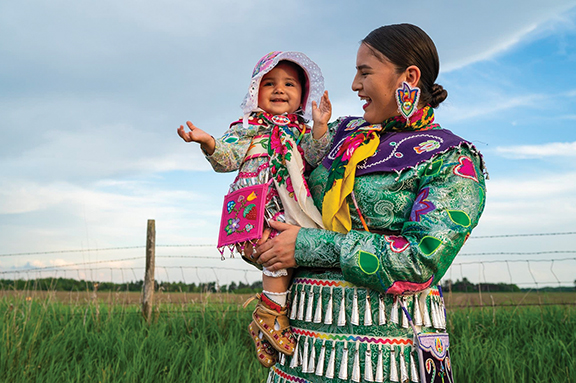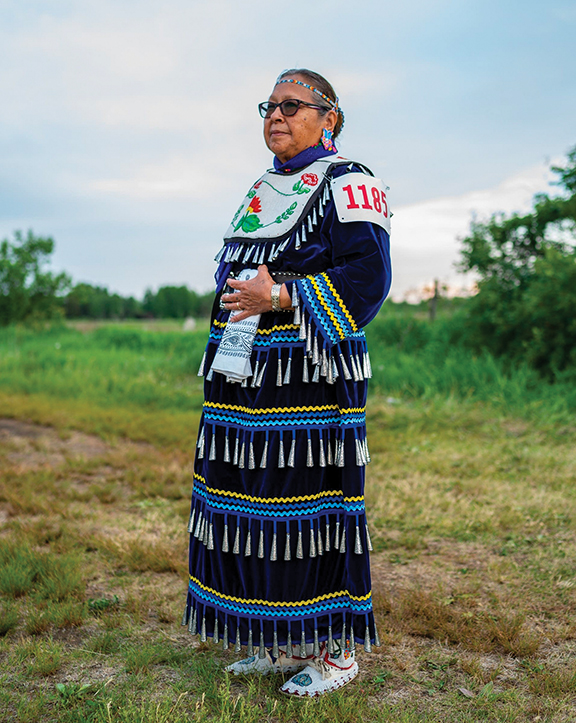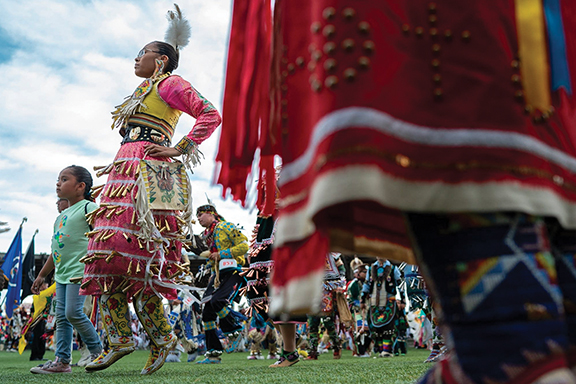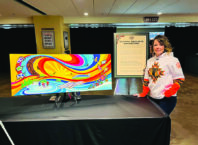
By Tim Nelson/MPR News
You can hear Mikah Whitecloud Hart coming from a long way away. She’s a jingle dress dancer, one of a group of women who parade in subtle rhythm at powwows, rattling rows and rows of small metal cones sewn like bells on their dresses, sometimes from their shoulders to their hemlines.
“That unique sound, there’s nothing like it,” she said at the Mille Lacs Band Grand Celebration Powwow on a June night in Hinckley. She was one of dozens of women there to meet, and to show off their work and dance.
Hart is a Red Lake band member who lives in Oklahoma and travels the powwow circuit.
She sews her own traditional cotton dresses and rolls her own jingles, in the traditional way – from the lids of Copenhagen snuff cans.
“When it’s just you and that drum, and hearing that – it’s an adrenaline rush, it’s heaven. It’s … there’s no other feeling that can describe it. It’s just love. Pure love on the dance floor. And I love this and I love this style and I love where I come from and being Ojibwe.”
Those jingle dresses, and that feeling, were celebrated on June 15th by Google, which commissioned one of its famed Google Doodle icons in honor of the Native American tradition – which has Minnesota roots.
In fact, the story of the jingle dress – part handicraft, part dance, and part mythology – is getting a closer look in a new exhibit from the Minnesota Historical Society’s Mille Lacs Indian Museum. The exhibit opened this spring and will run through the fall of 2020.
At its heart, the jingle dress is a cultural phenomenon, with a distinctive look and sound that, like drums, has become almost synonymous with Native American ritual and celebration.

Adrienne Benjamin is one of the region’s premier jingle dress makers. She teaches classes and takes orders for custom dresses – some with row after row of shiny metal sewn closely together for more intense sound, or more sparing, for a more austere and traditional presence.
“When you’re asking really about what makes a good dress, and over time, it is an expression not just the culture of our people, but of the artistry,” she said. The cut of the dress, the fiber of its fabric, the placement of the jingles can all speak to different times, different intentions.
Benjamin said some of the oldest examples are simply repurposed formal wear or plain cotton dresses. Newer, from-scratch versions have done away with any connection to tobacco tins and use machine-made, custom-tinted jingles and high tech, even neon-colored synthetic fabrics.
The new exhibit at the Mille Lacs Indian Museum on the history of the dresses features four of Benjamin’s creations, in pop-art-colored fabric.
Brenda Child (Red Lake Ojibwe) helped research and develop that exhibit. She’s a University of Minnesota professor, born on the Red Lake reservation, and a former trustee at the Smithsonian’s National Museum of the American Indian. Child may be the world’s leading authority on jingle dresses.
Which should come as no surprise. Although they’re now part of Native American culture from Maine to California, evidence points to the origin of the jingle dress practically in Child’s back yard, among the Mille Lacs Band of Ojibwe – where the tradition has been remembered, and part of the culture, for decades.
“We often hear a story about a little girl who fell ill, and her father had a vision, and after his vision, which was about this first jingle dress, he gave the dress to his daughter, and she got better. And it was sort of a miraculous kind of thing,” Child said.
Child turned her academic attention to the tale. “When I was doing research on the history of the jingle dress tradition, I noticed that I couldn’t find a single photograph in the United States or Canada, of what we would call a jingle dress, older than circa 1920,” she said.
Her conclusion: there weren’t any dresses to take pictures of back then.
She also knew the history of the 1918 flu pandemic, which was particularly devastating among the Native Americans around the Great Lakes. That may be the origin of the story of the girl who fell ill.

Those three artifacts – the family story, the photos and the flu – point to the origin of the dress not in the far reaches of Native tradition, but probably about 1919, Child said. The new historical society exhibit celebrates the centennial of its likely genesis – although the exact date will likely never be determined. Another band of Ojibwe, living in northwestern Ontario around Whitefish Bay, have a similar origin story.
Child said it’s an indication that history isn’t just in musty records and buried artifacts, but sometimes the imprint of surprisingly recent circumstances.
And she said it’s been very much a living history, noting that “the jingle dress dance was always a radical tradition.”
She said the dress’s appearance also coincided with a federal ban on ritual dancing on American Indian reservations in the 1920s. The sound of the jingles and the steps of the accompanying dance were acts of defiance and pride for Native women, Child said.
She said the tradition continues to evolve, and retains some of its reputation as a healing force, despite its origin in a time of tragedy and loss.
“You have it also emerging out of a moment in time, when Native people aren’t supposed to be doing it any more,” Child said. “But as the jingle dress has spread throughout the decades. You would have an event, like Standing Rock, and someone might say, ‘huh, that’s a new use of the jingle dress dance tradition.’ I think what you see it is still empowering women in their communities today.”
Minnesota Public Radio News can be heard on MPR’s statewide radio network or online.






